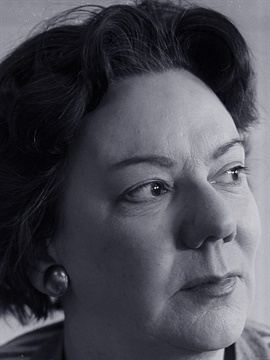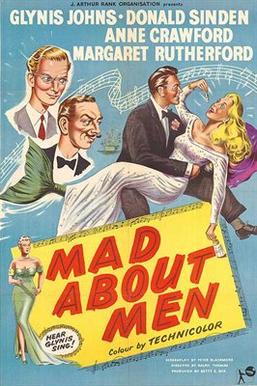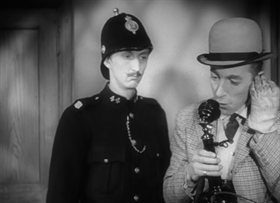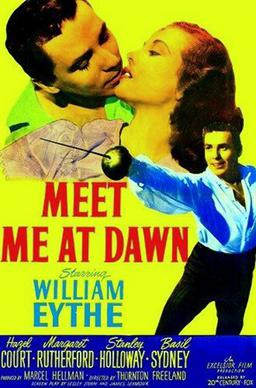
Dame Margaret Taylor Rutherford, was an English actress of stage, film and television.

Dandy Nichols was an English actress best known for her role as Else Garnett, the long-suffering wife of the character Alf Garnett who was a parody of a working class Tory, in the BBC sitcom Till Death Us Do Part.

Maurice Harington Kaufmann was a British actor of stage, film and television, who specialised in whodunits and horror films, from 1954 to 1981, when he retired.

Paul Carpenter was a Canadian actor and singer.

Richard Cameron Wattis was an English actor, co-starring in many popular British comedies of the 1950s and 1960s.
Jeannie Carson is a British-born retired comedian, actress, singer, and dancer. She has a star on the Hollywood Walk of Fame.

Above Us the Waves is a 1955 British war film about human torpedo and midget submarine attacks in Norwegian fjords against the German battleship Tirpitz. Directed by Ralph Thomas, it is based on two true-life attacks by British commando frogmen, first using Chariot manned torpedoes in Operation Title in 1942, and then X-Craft midget submarines in Operation Source in 1943. Filmed at Pinewood Studios, England, with outdoor scenes in Guernsey, some of the original war equipment was used in the film.

George Arthur Woodbridge was an English actor who appeared in films, television, and theatre ranging from the 1930s to the 1970s. Woodbridge's ruddy-cheeked complexion and West Country accent meant he often played publicans, policemen or yokels, most prominently in horror and comedy films alongside Christopher Lee and Peter Cushing.

Mad About Men is a 1954 British Technicolor comedy film directed by Ralph Thomas and starring Glynis Johns, Donald Sinden, Anne Crawford and Margaret Rutherford. It was written by Peter Blackmore, who also wrote the 1948 film Miranda which preceded Mad About Men. Johns appears in both films as the mermaid Miranda. However, Rank Films insisted it was not a sequel.

Wilfred William Dennis Shine was a British theatre, film and television actor. Shine was born into a family of theatre actors; among others, Shine's father, mother, grandmother, two uncles and an aunt had worked in theatre. His father Wilfred Shine was a theatre actor who also appeared in films during the 1920s and the 1930s. Bill Shine made his film debut in 1929, since which he appeared in over 160 films and television series. Towards the end of his career, he was best known for playing Inventor Black on children's television series Super Gran. In series two, episode four, of Mrs Thursday, 'The Duke and I', (1967), he played the Duke of Midlothian.
Earl St. John was an American film producer in overall charge of production for The Rank Organisation at Pinewood Studios from 1950 to 1964, and was credited as executive producer on 131 films. He was known as the "Earl of Pinewood". John Davis of Rank called him "the greatest showman that The Rank Organisation has ever had, and probably the greatest showman to have lived in this country. "

Quiet Wedding is a 1941 British romantic comedy film directed by Anthony Asquith and starring Margaret Lockwood, Derek Farr and Marjorie Fielding. The screenplay was written by Terence Rattigan and Anatole de Grunwald based on the play Quiet Wedding by Esther McCracken. The film was remade in 1958 as Happy Is the Bride.

As Long as They're Happy is a 1955 British musical comedy film directed by J. Lee Thompson and starring Jack Buchanan, Susan Stephen and Diana Dors. It is based on the 1953 play of the same name by Vernon Sylvaine. It was shot in Eastmancolor at Pinewood Studios near London with sets designed by the art director Michael Stringer.

Seven Keys is a 1961 British second feature crime thriller directed by Pat Jackson and starring Alan Dobie.

Cyril Chamberlain was an English film and television actor. He appeared in a number of the early Carry On, Doctor and St. Trinian's films.
Albert Patrick Jordan was a British stage, film and television actor.

Meet Me at Dawn is a 1947 British romantic comedy film directed by Peter Creswell and Thornton Freeland and starring William Eythe, Stanley Holloway and Hazel Court. The screenplay concerns a very skilled pistol shot who hires himself out to fight and duels in early twentieth century Paris.

George Moon was an English stage, film and television actor.
Charles Carson was a British actor. A civil engineer before taking to the stage in 1919, his theatre work included directed plays for ENSA during WWII.
Arnold Bell was a British actor.















